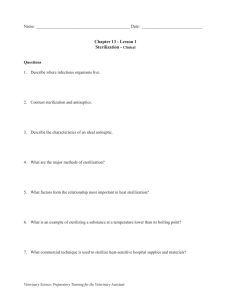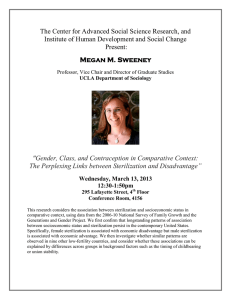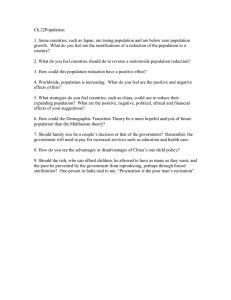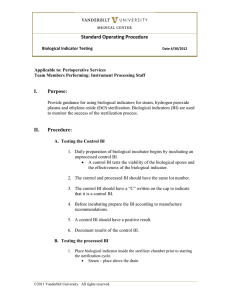Here - OSAP
advertisement
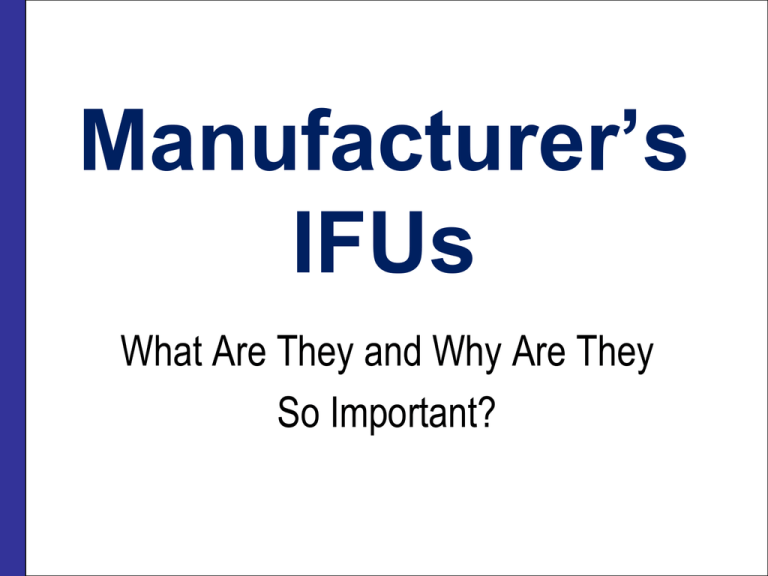
Manufacturer’s IFUs What Are They and Why Are They So Important? Speaker Disclaimer Chuck Hughes VP, Infection Prevention Consulting Services SPSmedical Supply Corp. now part of Crosstex International 6789 W. Henrietta Road · Rush, NY 14543 USA (800) 722-1529 · E-mail: chughes@SPSmedical.com Certified as a Health Education teacher, Chuck has worked for over 25 years in the manufacturing industry in areas of Regulatory Affairs, R&D, Marketing, Microbiology and Sterilization Training. He is a corporate member AORN, AST, IAHCSMM, OSAP, and numerous other organizations, including AAMI and CSA where he contributes to sterilization standards. A popular speaker at regional, national and international Health care conferences, Chuck has visited thousands of health care facilities during his career providing infection prevention consulting services that include fee based and complimentary audits of instrument reprocessing areas. Objectives At the end of this program, participants will be able to: • explain what IFU stands for, • discuss why manufacturer’s IFUs are important to have and to comply with, • describe how to secure manufacturer’s IFUs. Manufacturer’s IFU (Instructions For Use) In the U.S. medical device industry, IFU stands for “instructions for use” and in Canada they say MIFU which stands for “manufacturer’s instructions for use”. Reusable medical devices are a critical component of modern health care and for patient safety reasons, they must be reprocessed according to the manufacturer’s (MFR’s) written and validated IFU. With instruments and other medical devices becoming more and more complex, having and following each MFR’s IFU is critical. New FDA Regulations The FDA released a new guidance document on 3/17/15 explaining what is now required of MDMs who request 510(k) clearance for a new device. For reusable medical devices, validated reprocessing instructions are expected. Recently, the Dental Trade Association (DTA) met with the FDA and discussed the new regulations, along with the issues in a 510(k) application that can result in a Refuse to Accept letter (denial). http://www.fda.gov/downloads/MedicalDevices/DeviceRegulationandGuidance/GuidanceDocuments/UCM253010.pdf Medical Device Regulations These new FDA regulations require medical and dental instrument manufacturers to validate their product label claims of reusability and provide complete and comprehensive written IFUs for: • • • • • cleaning, disinfection, testing, packaging, sterilization and drying. Medical Device Regulations Other device manufacturers, such as sterile packaging, chemical and biological indicators, as well as sterilizer are also being required to provide written IFUs. Sterilizer Manufacturers Are being required to validate to AAMI standard cycles to avoid conflicting IFUs with sterile packaging systems and sterilization indicators used to monitor their cycles. Medical Device Manufacturers Validating to AAMI standard cycles is also being required for new instruments, sterile packaging (pouches, wraps, containers and cassettes), chemical indicators or integrators and biological indicators (also called spore tests). MFR’s IFU (Instructions For Use) For patient safety, compliance with MFR’s written IFUs is stated in AAMI Standards, such as ST79 and the CDC Infection Control Guidelines (dental is being updated this year). ANSI/AAMI ST79:A4:2013 Considered the bible of sterilization, this comprehensive guide to steam sterilization in healthcare facilities covers all aspects of facility design, personnel and reprocessing procedures. Order Code: AAMI ST79 List Price: $290.00 plus shipping Member Price: $174.00 plus shipping www.aami.org Where Do You Get MFR’s IFUs? Many health care facilities rely on Sales Representatives to provide IFUs; however, I recommend you contact the device manufacturer’s Corporate office and ask for Quality Control or Regulatory Affairs. Quality Control and/or Regulatory Affairs personnel are the ones most familiar with IFUs and should be eager to provide them to you. Where Do You Get MFR’s IFUs? Another option is to hire a Company to do the search for you and to keep the MFR’s IFU updated. For a monthly or annual fee, they provide you with an internet based library with electronic copies that can be printed out. It is important to know… National survey organizations now audit health care facilities for strict compliance with standards, guidelines, and MFR’s IFUs. June 15, 2009 - Update on The Joint Commission's Position Based on discussions with experts in the field, professional organizations, and government organizations, The Joint Commission has decided to refocus its survey efforts on all of the critical processes included in sterilization. If a complete and effective process of sterilization is used, it will be considered an effective sterilization method. Therefore, surveyors will review the critical steps of disinfection and sterilization to determine if the process is appropriate. Here is a brief overview of the 3 critical steps of reprocessing: 1. Cleaning and decontamination. All visible soil must be removed prior to sterilization because steam and other sterilants cannot penetrate soil, particularly organic matter. Manufacturers’ instructions are available for all instruments; these include directions for the cleaning and decontamination process. Some smooth metal instruments may be easily brushed clean, while complex products may require disassembly and special cleaning techniques. Many manufacturers specify that an enzymatic soak be used as well. 2. Sterilization. Most sterilization is accomplished via steam, but other methods are also available. Steam sterilization of all types, including flashing, must meet parameters (time, temperature and pressure) specified by both the manufacturer of the sterilizer, the maker of any wrapping or packaging, and the manufacturer of the surgical instrument. In addition to these instructions, physical, chemical and biological controls must be used as designed and directed by their manufacturers. 3. Storage or return to the sterile field. Each newly sterilized instrument must be carefully protected to ensure that it is not re-contaminated. For full steam sterilization cycles, packs of instruments are wrapped and sealed. Instruments subjected to steam sterilization using methods other than full cycle sterilization may be transported in “flash pans” or other devices specifically designed for the prevention of contamination during and after the steam process. In summary, Joint Commission surveyors will focus on all of the critical steps and the integrity of the sterilization process. The Centers for Medicare & Medicaid Services (CMS) has recently revised their Survey and Certification document to include more stringent audits in the areas of infection control and sterilization. Areas of emphasis include: • Compliance with nationally recognized standards/documents. • • • Formal training in areas of infection control and sterilization. Compliant cleaning, sterilization and monitoring procedures. Established criteria for flash sterilization. Reference: CMS Infection Control Surveyor Worksheet, Exhibit 351, 2009. The Accreditation Association for Ambulatory Healthcare (AAAHC) added an infection control chapter to their standards handbook. Infection control highlights included: “Adhering to standards, guidelines, and manufacturer’s instructions for cleaning, disinfection, and sterilization of instruments, equipment, supplies, and implants.” Reference: OR Manager Magazine, Volume 26, Number 2, 2010. July 20, 2011 - Joint Commission Online Beginning in 2010, surveyors have spent additional time during surveys evaluating the cleaning, disinfection and sterilization processes. Earlier this year, Joint Commission surveyors received in-depth training on sterilization processes. This education was provided in collaboration with AAMI and included a review of all aspects of the AAMI ST79 guideline on steam sterilization. Instructions for Use (IFU) It is critical you follow the device MFR’s validated cleaning IFU with regards to water temperature, water type, brush, detergent and specific cleaning procedures. It is also critical to follow device MFR’s validated sterilization IFU with regards to which process and cycle parameters. Why Are IFUs Important? “If manufacturer’s instructions are not followed, then the outcome of the sterilizer cycle is guesswork, and the practice should be cited as a violation of Section 42 CFR 416.44(b)(5).” Centers for Medicare & Medicaid Services (CMS) So, let’s take a look at some existing DENTAL IFUs to see what dental reprocessing personnel are dealing with… Young Dental Sug-O-Vac Evacuator Tip December 3, 2012 Re: Surg-O- VacTM autoclave information request The Young Dental Sug-O- Vac plastic high volume evacuator tips can be autoclaved up to 135°C prior to use per autoclave instructions. Although the tip may be autoclaved prior to use, the product remains a single use device, and must be disposed of after one use. The initial autoclave may be done at the user’s discretion according to the autoclave manufacturer’s recommendations. Please let me know if you have any additional questions or concerns. Sincerely, Sarah Moore Regulatory Affairs What’s missing? ITL Dental Adjustable Torque Wrench Cleaning & Autoclaving Before initial use and after each procedure, clean the torque wrench with a wet towel or disinfectant wipe. Rinse under warm tap water and wipe dry. The torque wrench may be autoclaved. Follow the autoclave manufacturer’s instructions. 20 minutes at 135°C (275°F) is recommended. Do not store is sealed autoclave bag. After autoclaving, rotate the setting dial to ensure that the wrench is operating correctly. What about this? Anything missing? 3M ESPE Elipar S10 LED Curing Light Sterilization Effective cleaning and disinfection are absolutely essential requirements for effective sterilization. Only steam sterilization is approved as a sterilization procedure: - Maximum sterilization temperature 134°C (273°F) - Sterilization time (exposure time at sterilization temperature) at least 20 min. at 121°C (250°F) or at least 3 min. at 132°C (270°F) /134°C (273°F). These cycles do not match AAMI standard cycles DUX Dental Sterilizing Procedures for Bur Blocks, Code Rings*, Set-up Trays, Instrument Mats, Mirrors, SteriCassettes and SteriCages These items can be processed through an autoclave or Chemiclave cycle. The time/temperature ratio of the moist heat cycle is determined when selecting the appropriate (unwrapped, wrapped, pouches, packs) cycle, as determined by the manufacturer of the equipment. Any cycle is appropriate to process all plastics where the heat does not exceed 275ºF. A biological monitor is always recommended to assure that sterilization has taken place. What does the FDA say about who is responsible for validating the cycle parameters? Hu-Friedy Dental Hand Instruments and Accessories 3.1.4.2 Manual Cleaning Procedure: Cleaning 1. Completely disassemble the instruments, if applicable. 2. Soak the disassembled instruments for the recommended soaking time in the cleaning solution and make sure that the instruments are sufficiently immersed. If applicable: Rinse all lumens of the instruments five times at the beginning and at the end of the soaking time with a single-use syringe (minimum volume 50 ml) or a suitable rinsing adapter. 3. Remove the instruments from the cleaning solution and post rinse them intensively with low contaminated and deionized water (i.e. aqua purificata). 4. Inspect the instruments for proper cleaning. Lumens are very difficult to clean, as seen by this MFR’s validated cleaning IFU. Hu-Friedy Dental Hand Instruments and Accessories 3.1.4.3 Ultrasonic Cleaning The use of a cassette system like the Hu-Friedy IMS-System is recommended (limitations see 4.0 Special Procedures section). Procedure: Cleaning 1. Completely disassemble the instruments if applicable. Soak the disassembled instruments for the recommended soaking time in the cleaning solution, and make sure that the instruments are sufficiently immersed. Use the processing time recommended by the manufacturer of the detergent and/or the cassette system. Note: There should not be any contact between the instruments. If applicable: Rinse all lumens of the instruments five times at the beginning and at the end of the soaking time by application of a single-use syringe (minimum volume 50 ml). 2. If you are using the IMS Cassette System, the ultrasonic cleaning time has to be at least 16 minutes, unless a longer exposure time is required by the manufacturer of the detergent. Do not overload the Ultrasonic Cleaning unit. Use “Sweep modus” if available. 3. Remove the instruments from the cleaning solution and post rinse them intensively with low contaminated and deionized water (i.e. aqua purificata) for best results. 4. Inspect the instruments for a good cleaning result. Hu-Friedy Dental Hand Instruments and Accessories 3.5 Sterilization Please use only the recommended sterilization procedures listed below. Other sterilization procedures are the responsibility of the user. Hu-Friedy recommends a 30 minute dry time; however defer to the manufacturer’s instructions for the equipment used. 3.5.1 Steam sterilization - fractionated vacuum or gravity procedure - Sufficient product drying must be ensured after sterilization and before handling, see table below for recommendations. - steam sterilizer according to or AAMI/ANSI ST55 and AAMI/ANSI ST8 - validated according to or ANSI/AAMI ST79 (valid IQ/OQ (commissioning) and product specific performance qualification(PQ)) Minimum cycle times for gravity-displacement steam sterilization cycles Item Exposure time at 121°C (250°F) Drying times Wrapped instruments 30 minutes 30 minutes Minimum cycle times for dynamic-air-removal steam sterilization cycles Item Exposure time at 132°C (270°F) Drying times Wrapped instruments 4 minutes 30 minutes These cycles match AAMI standard steam sterilizer cycles. Star Dental Titan Low Speed Handpiece Motor Sterilization 1. After each patient, flush air by running handpiece motor for 20 seconds. 2. Remove attachment. 3. Clean all internal surfaces at rear of handpiece motor with a cotton swab soaked in isopropyl alcohol until clean. 4. Clean all external surfaces using a small toothbrush with isopropyl alcohol. 5. Dry thoroughly. 6. Place handpiece motor and swivel in sterilization bag – use paper or paper/plastic bags only. Follow the sterilization guidelines as stated by the manufacturer of your sterilizer. 7. Remove handpiece motor from sterilizer after drying cycle ends and allow to cool in bag. The handpiece motor must be cleaned and sterilized between patient use. A wrapped handpiece motor should be steam sterilized at 132°C for a minimum of 10 minutes or at 121°C for a minimum of 50 minutes. Do not exceed 135°C. An unwrapped handpiece motor should be steam sterilized at 132°C for a minimum of 8 minutes or at 121°C for a minimum of 30 minutes. Do not exceed 135°C. Again, no description of what type of steam sterilizer and both cycles do not match AAMI cycles. Dental Handpieces Device MFG. Device Description Process Time/Temperature/Dry ADEC W&H Synea Lighted HS Handpieces Steam Pre-vacuum Steam Gravity 4 min @ 134°C/273°F 6 min @ 121°C/250°F W&H TReND LS Straight Handpiece and Contra-angle Handpieces Steam Pre-vacuum Steam Gravity 3 min @ 134°C/274°F 4 min @ 134°C/274°F Anthogyr NiTi Control Endo Handpiece Steam 18 min @ 135°C Kavo Dental MULTIflex HS Handpieces Steam or C-Vapor up to max 135°C/275°F Piezosurgery Inc. Dental Handpiece Autoclave 4 min @ 134°C/273°F 16 min @ 121°C/250°F *In accordance with ANSI/AAMI ST42:1998 Sabra Dental Handpieces ANSI/AAMI ST79:A4 2013 Autoclave Steam Dynamic Air Removal* *Pre-vacuum or SFPP Not a single IFU matches these AAMI cycles! Steam Gravity Displacement 15 min @ 132°C 20 min @ 121°C 4 min @ 132°C/270°F 3 min @ 135°C/275°F 10 min @ 132°C/270°F 30 min @ 121°C/250°F CONCLUSION As you can see, there is a wide variance in MFR’s IFUs. However, for patient safety, compliance with Standards, and to stay out of the national Media; you must have and must follow each device MFR’s validated IFU. THANK YOU! Chuck Hughes VP, Infection Prevention Consulting Services SPSmedical Supply Corp. now part of Crosstex International 6789 W. Henrietta Road · Rush, NY 14543 USA (800) 722-1529 · E-mail: chughes@SPSmedical.com Certified as a Health Education teacher, Chuck has worked for over 25 years in the manufacturing industry in areas of Regulatory Affairs, R&D, Marketing, Microbiology and Sterilization Training. He is a corporate member AORN, AST, IAHCSMM, OSAP, and numerous other organizations, including AAMI and CSA where he contributes to sterilization standards. A popular speaker at regional, national and international Health care conferences, Chuck has visited thousands of health care facilities during his career providing infection prevention consulting services that include fee based and complimentary audits of instrument reprocessing areas. References & Resources Association for the Advancement of Medical Instrumentation 1110 North Glebe Road, Suite 220, Arlington, VA 22201-4795 703-525-4890 Fax: 703-276-0793 www.aami.org Accreditation Association for Ambulatory Health Care (AAAHC) 5250 Old Orchard Road, Suite 200 · Skokie, IL 60007 www.aaahc.org Centers for Disease Control and Prevention 1600 Clifton Road Atlanta, GA 30333 800-232-4636 www.cdc.gov Centers for Medicare & Medicaid Services (CMS) 7500 Security Boulevard · Baltimore, MD 21244 www.cms.gov The Joint Commission (TJC) One Renaissance Boulevard · Oakbrook Terrace, IL 60181 www.jointcommission.org
